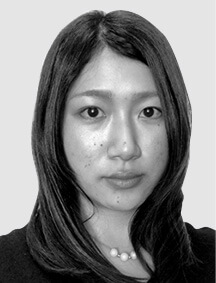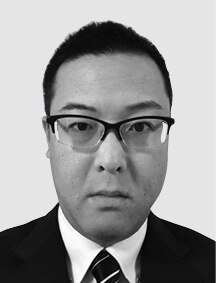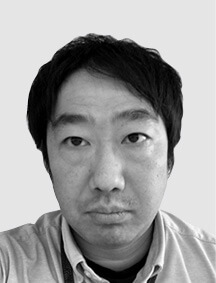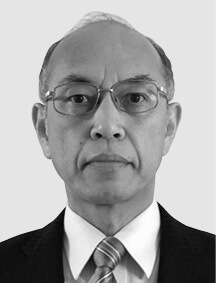Innovation for Next-generation Energy[ⅰ]Power GridsKey Technologies Used in Hida-Shinano HVDC LinkLeading-edge HVDC Transmission Project
Highlight
The Hida-Shinano high voltage direct current link currently under construction connects the 50-Hz Shin Shinano substation of TEPCO Power Grid, Inc. to the 60-Hz Hida converter station of Chubu Electric Power Grid Co., Inc. It is the first such project in Japan in which a high voltage direct current link connects via overhead lines between grids operating at different frequencies and with different manufacturers supplying the systems at each end. Hitachi had full responsibility for the AC/DC converter system at Hida converter station and adopted a development design that took account of the environmental conditions of heavy snowfall associated with the station’s high altitude (1,085 m).
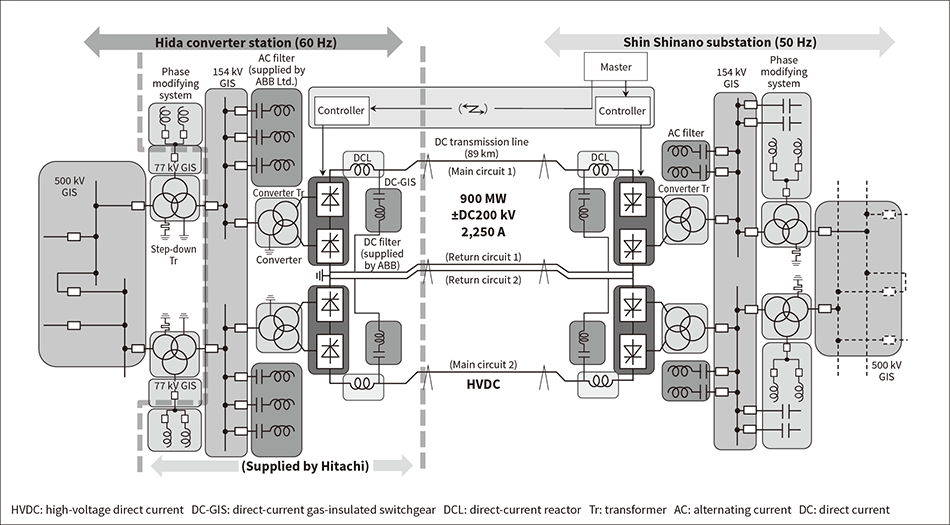
1. Introduction
The Great East Japan Earthquake highlighted the need for more electricity capacity during major disasters. This led to the launch of a project to build a high voltage direct current (HVDC) link between the Tokyo and Chubu regions in order to increase the capacity for transferring power between Japan’s 50-Hz and 60-Hz grids(1).
Along with its ability to serve as a link between grids that operate at different frequencies, the features of HVDC are also useful for lowering long-distance transmission losses and expanding and strengthening the power system. Given the rising adoption of renewable energy, it is anticipated that HVDC will become even more important in the future, including as a means of providing greater capacity for cross-regional interconnection and the transmission of large amounts of offshore wind or other forms of renewable energy generated in remote locations.
Construction of the Hida-Shinano HVDC Link is currently underway as part of the project referred to above, with a scheduled date for commencing operation of March 2021. Hitachi’s scope of work includes the supply of thyristor valves, converter transformers, direct-current reactors (DCLs), alternating-current gas-insulated switchgear (AC-GIS), direct-current gas-insulated switchgear (DC-GIS), control and protection systems, harmonic filters, and phase modifying systems for the Hida converter station of Chubu Electric Power Grid Co., Inc.
This article describes the features of key equipment supplied to the project that were optimized to suit the specific specifications and conditions of Hida converter station.
2. System Configuration
Fig. 1—Main Circuit Configuration of Hida-Shinano HVDC Link Hitachi supplied the full converter system for the Chubu Electric Power Grid Co., Inc. (60 Hz) side of the Hida converter station.
Hitachi supplied the full converter system for the Chubu Electric Power Grid Co., Inc. (60 Hz) side of the Hida converter station.
Table 1—Specifications and Conditions for Hida-Shinano HVDC Link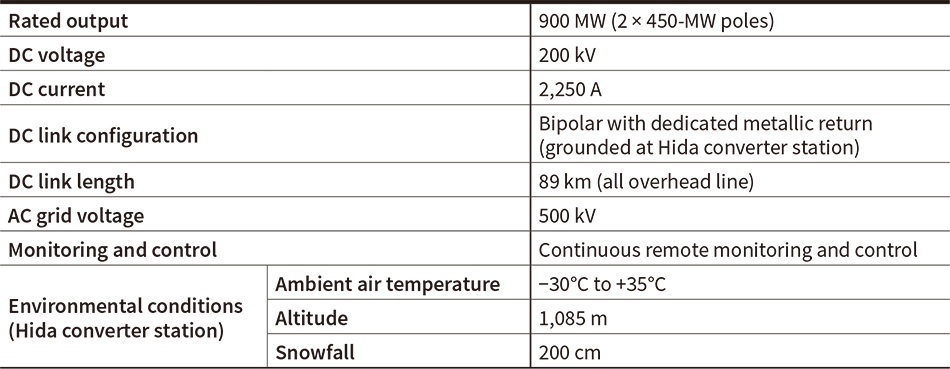 The table lists the main specifications of the Hida-Shinano HVDC Link, with the environmental conditions being those for the Hida converter station of Chubu Electric Power Grid.
The table lists the main specifications of the Hida-Shinano HVDC Link, with the environmental conditions being those for the Hida converter station of Chubu Electric Power Grid.
Hida-Shinano HVDC Link runs over 89 km of overhead lines connecting the Shin Shinano substation of TEPCO Power Grid, Inc. in Nagano Prefecture to the new Hida converter station of Chubu Electric Power Grid Co., Inc. in Gifu Prefecture. The link has a capacity of 900 MW (2 × 450-MW poles) and operates at a DC line voltage of 200 kV. Figure 1 shows the circuit diagram and Table 1 lists the main specifications and conditions. While DC converter systems already exist that connect between grids that operate at different frequencies, this is the first such HVDC link in Japan to use overhead lines. Hitachi’s role in the Hida-Shinano HVDC Link project was to supply the complete AC/DC converter system for the Hida converter station. This is the HVDC system that involves two different manufacturers, with Shin Shinano substation as the master station and Hida converter station as the secondary station. The overall system relies on cooperative control between the systems at each end for things like starting and stopping the link, the exchange of signals for protection interlocking, and the timing of protection mode initiation. Accordingly, simulation trials were conducted at Shin Shinano substation during 2018 that simulated the two manufacturers’ control and protection systems. This was followed by connection testing, which commenced after installation of the converter and its control and protection systems and is still in progress.
Equipment installation completed in November 2019 and de-energized connection tests between the two stations took place at Hida converter station from February to April 2020. Grid connection testing will commence in October 2020 with the link scheduled to enter service in March 2021. Figure 2 shows an aerial photograph of Hida converter station in September 2019. The equipment supplied to the station included an imported filter with a phase modifying function (supplied by ABB Ltd.). In developing the system, Hitachi also set out to optimize it to suit the alpine environmental conditions at Hida converter station, which include a temperature range of −30°C to +35°C, an altitude of 1,085 m, and snowfalls of 200 cm.
The following sections describe the features of the thyristor valves, DC-GIS, converter transformers, phase modifying/filter systems, and control and protection systems, all of which play a key role in the system.
Fig. 2—Arial Photograph of Hida Converter Station The photograph shows the Hida converter station on its site of approximately 60,000 m2 (photograph taken in September 2019).
The photograph shows the Hida converter station on its site of approximately 60,000 m2 (photograph taken in September 2019).
3. Thyristor Valves
Fig. 3—450-MW Thyristor Valve The thyristor valves have a four-arm stacked configuration with six modules per arm.
The thyristor valves have a four-arm stacked configuration with six modules per arm.
Fig. 4—Thyristor Valve Module Six 8-kV/2,490-A light-triggered thyristors with a VBO function are connected in series. In the event of a fault in one of the thyristor modules components, replacement of individual parts is available rather than replacement of the entire module.
Six 8-kV/2,490-A light-triggered thyristors with a VBO function are connected in series. In the event of a fault in one of the thyristor modules components, replacement of individual parts is available rather than replacement of the entire module.
The thyristor valves are the devices used in the DC transmission system to convert from alternating current (AC) to DC and from DC back to AC. The Hida converter station uses light-triggered thyristor valves of the air-insulated, water-cooled type, a device type that has already been proven in use at other frequency converter stations in Japan.
The thyristor valves have rated values of 450 MW for capacity, 200 kV for DC voltage, and 2,250 A for DC current. They have a four-arm stacked configuration with six modules per arm (see Figure 3). Each module is comprised of six 8-kV/2,490-A thyristors connected in series (see Figure 4).
Key features of the thyristor valve design are as follows.
- Use of light-triggered thyristors with a voltage break over (VBO) function
This is the first time Hitachi has used thyristors with a VBO function in an HVDC system. In the event of the applied voltage exceeding a certain level, the device turns itself on to prevent a thyristor overload. Furthermore, because the design of the thyristor module allows for the replacement of individual parts, replacement and recovery can be performed quickly should one of the components fail. - Valve configuration and dimensions chosen based on transportation and on-site work volume considerations
The thyristor valves are designed to be assembled and disassembled in the vertical direction only, with dimensions chosen to allow for assembly and disassembly at the factory as well to satisfy transportation constraints and reduce on-site work. - Seismic performance evaluation
An analytical model was used to perform a characteristic frequency analysis of the structural design of the thyristor valves. The characteristic frequency of the actual equipment was also measured to evaluate the seismic performance of the thyristor valves. This demonstrated good agreement between the predicted and actual measurements, indicating that the structure of the thyristor valves satisfied the seismic requirements. - Rationalization of cooling system specifications and use of rotary control
The thyristor valves are cooled by a closed-loop water-cooling system, with the cooling water in turn being cooled by an outdoor system via a heat exchanger. The number of cooling system units was rationalized to take account of the fact that the thyristor valves are installed at an altitude of 1,085 m and that the maximum outdoor ambient temperature is set at 35℃. Furthermore, rotary control was used to determine which cooling units to operate and to balance their operating times.
4. DC-GIS
Fig. 5—DC-GIS DC-GIS is encased in metal to allow for factors such as the altitude, ambient air temperature, and snowfall. Hitachi’s DC-GIS will be the first one to operate at Hida converter station.
DC-GIS is encased in metal to allow for factors such as the altitude, ambient air temperature, and snowfall. Hitachi’s DC-GIS will be the first one to operate at Hida converter station.
Hida converter station is located at an altitude of 1,085 m where it is subject to snowfalls of 200 cm and ambient air temperatures of −30°C to +35°C. To allow for these environmental conditions, the system uses DC-GIS (main circuit rated voltage: DC 200 kV, return circuit rated voltage: DC 10 kV, rated current: DC 2,250 A) that is equipped to deal with the external environment, with live parts being encased in a metal enclosure (see Figure 5). As well as featuring a high level of safety with respect to electric shock and reduced maintenance requirements due to a lack of potential degradation due to the environment, the many benefits of the DC-GIS include excellent seismic performance and scope for reducing the required site area.
DC-GIS requires an electric field design that depends on the DC resistivity, with a need for the design to take account of the potential for insulators to become charged and the effect of metallic particles, the most important factors in DC insulation. Accordingly, along with full-scale verification testing, Hitachi also incorporated the latest technology from AC-GIS to establish design techniques for highly reliable DC-GIS.
The lightning arresters in the DC-GIS are important for coordinating the insulation in the DC system. Hitachi developed a tank type arrester design that uses long-life elements designed specifically for DC, with use of analytical techniques to determine where to locate the shielding so as to keep the electrical potential uniform. Similarly, zero-flux current transformers were used for the DC current transformers that are important for protection and control of the DC system, and resistance-capacitance divider type were adopted for the DC voltage transformers. Because these were new components for a DC application, testing included not only error and other performance assessment but also verification of the full instrumentation system installed in the GIS (including control panel) to confirm that both performance and quality were adequate.
Testing was also conducted to ensure the insulation, temperature rise, and switching performance under DC conditions of the various other components, including disconnectors, earthing switches, air-insulated bushing, and gas-oil-insulated bushing. All of these components were used to build a highly reliable DC-GIS.
5. Converter Transformers
To enable the converter transformers to be broken down into a form suitable for transportation and the available installation space, a special three-phase transformer was used that was made up of three tanks, each comprised of a single-phase four-leg core with Y-Y-connected primary legs and Y-Δ-connected secondary legs.
Because the environmental conditions at Hida converter station (outdoor temperature range of −30°C to +35°C, altitude of 1,085 m) are outside the standard conditions specified in JEC-2200-2014 (−20°C to +40°C, altitude ≤ 1,000 m), a low-temperature oil with a lower than normal pour point was used to maintain oil fluidity at the −30°C minimum temperature without compromising heat and insulation performance. Similarly, the design and manufacture of the transformer included changes to the air insulation distances and adjustments to the temperature rise limit and withstand voltage test values in order to carry out factory testing that takes into account the effects of low atmospheric pressure of high altitude.
Similar to previous converter transformers, a detailed study of the electric field at points inside the windings was conducted and adequate consideration was given to the particular characteristics of this type of transformer, namely higher no-load losses and noise level due to DC-biased magnetization and higher load losses due to harmonic currents. This resulted in the manufacture of highly reliable transformers.
6. Filter and phase modifying system
Fig. 6—AC Filter The system uses imported air-insulated filters. Backups are provided for each of the two poles of AC/DC converter, giving a total of four groups of filters. The DC filter is located behind the AC/DC converter building.
The system uses imported air-insulated filters. Backups are provided for each of the two poles of AC/DC converter, giving a total of four groups of filters. The DC filter is located behind the AC/DC converter building.
The Hida converter station was the first such AC/DC station in Japan to use an imported air-insulated filter (supplied by ABB). The filter is composed of a capacitor bank in which can-type units are connected in series and parallel, an air-core dry-type reactor, and a dry-type resistor, all of which are self-cooled. Efficient suppression of voltage distortion is achieved by a double-tuned filter that makes use of the degree of freedom where the air insulation is located.
As shown in Figure 6, each AC filter group is made up of the following four types of filter: (1) 11/13th-order band-pass (BP) filters and 23/35th-order high-pass (HP) filters that suppress the outflow of harmonic currents from the AC/DC converters, (2) 5/7th-order HP filters to prevent the harmonics present on the AC system from affecting the AC/DC converters, and (3) 3rd-order C-type filters that suppress the third-order harmonics induced by the negative-phase voltage component of the AC system through interaction between the AC system, the AC/DC converter, and DC system. On the DC side, harmonic currents flowing into the DC transmission line due to harmonic voltages generated by the AC/DC converters are suppressed by the 12/24th-order HP filter.
For the AC filters, the reliability of the overall AC/DC converter system is improved by configuring each pole as two redundant groups. The use of four groups of AC filters makes it possible to adjust the leading capacity by selectively turning backup filters on or off. This is the first time a phase modifying system has been implemented in Japan in combination with shunt reactors (ShRs).
Being located in a region subject to heavy snowfalls of 200 cm, all of the filter components are installed on supports that raise them by 200 cm to prevent accumulations of snow from reducing the insulation distance to earth. Similarly, the roofs were all designed with a steep pitch to ensure that snow slides off and to eliminate any impact of snow accumulation on the seismic design. Care was also taken not to place equipment at locations where snow would fall onto it.
For the seismic design, overseas manufacturers use a modal response spectrum analysis based on IEEE 693, which differs from the time history modal response analysis based on JEAG 5003 used in Japan. For this reason, the response spectrum used in the seismic design was the JEAG 5003’s 3 m/s2 sine wave converted for the purpose of applying the IEEE 693 method(2).
7. Control and Protection Systems
Fig. 7—Control and Protection System Configuration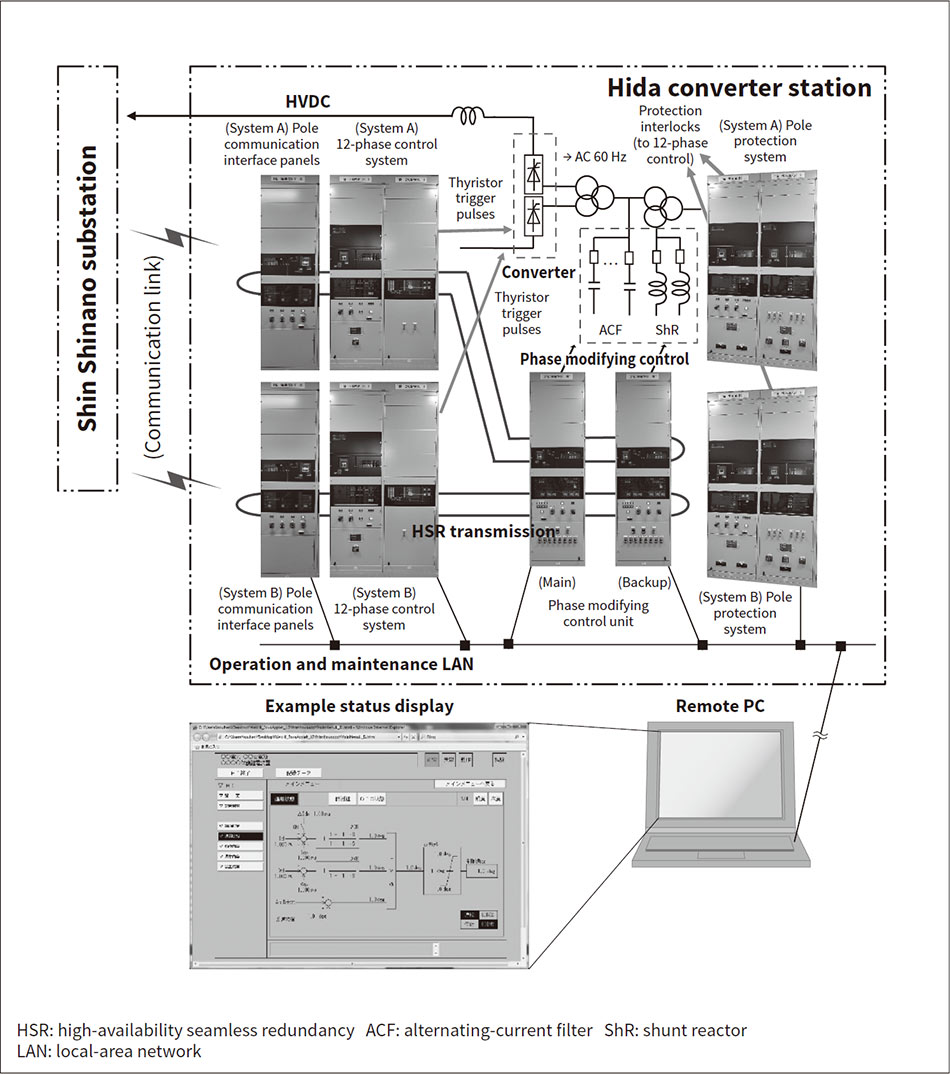 The 12-phase control system outputs thyristor trigger pulses, the pole protection system outputs protection interlocks, and the phase modifying control unit controls the ACFs and ShRs. Information on each system can be accessed remotely via the on-site LAN.
The 12-phase control system outputs thyristor trigger pulses, the pole protection system outputs protection interlocks, and the phase modifying control unit controls the ACFs and ShRs. Information on each system can be accessed remotely via the on-site LAN.
Fig. 8—HSR Communication between Equipment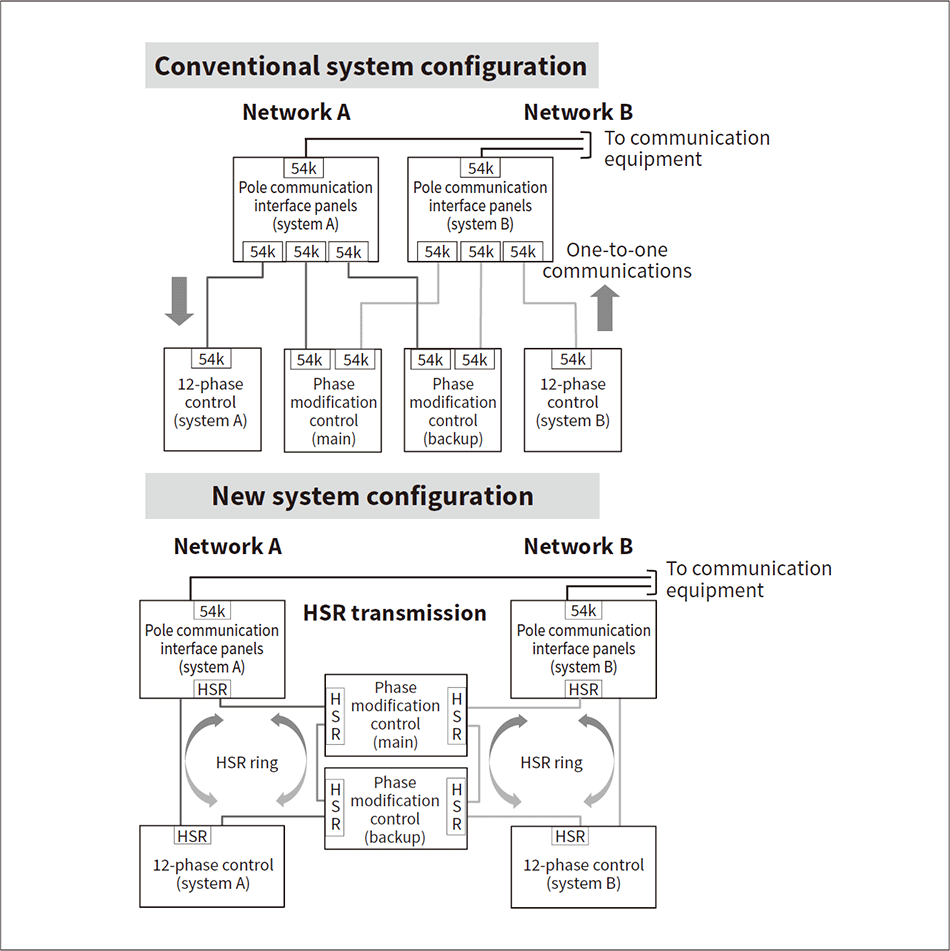 Connecting devices in a loop provides redundancy while also reducing the number of input and output interfaces.
Connecting devices in a loop provides redundancy while also reducing the number of input and output interfaces.
Control and protection systems have an important role in the operation of the converter system, including control of the thyristor valves and equipment protection. Accordingly, the reliability of the Hida-Shinano HVDC Link is maintained through built-in redundancy that prevents the failure of any one component from impeding system operation. The main functions are as follows.
- Control of thyristor valve trigger phase angle in AC/DC conversion
AC/DC conversion is controlled by sensing of the conditions on the AC and DC systems and then outputting trigger pulses to the thyristor valves at the appropriate timings (phase angle) based on control commands from the Shin Shinano master station. This involves high-speed processing because of the need for coordination with the continuously changing state of the 60-Hz grid and the master station commands. - Coordinated protection operation that depends on the nature of the fault
While the AC system is protected by opening circuit breakers, the DC system requires coordinated protection that involves correctly timing the opening of AC circuit breakers along with thyristor valve gate control. This coordinated protection detects the different types of abnormalities that occur under different fault scenarios, such as faults in the converter equipment or irregularities in the AC or DC systems, and selects the best protection pattern to shut the system down safely. - Use of backup AC filters for control of phase modification
Phase modification control keeps reactive power in balance with the AC system by connecting and disconnecting phase modifying systems according to the interchange power to compensate for the reactive power consumption of the AC/DC converter. Phase modification at the Hida converter station is achieved not only by the ShRs but also by utilizing the backup AC filters, a configuration never before used in Japan. Two banks of filters are provided for each order of AC filter, with one bank being dedicated to suppressing harmonics while the filters in the other (backup) bank are switched in and out to provide reactive power compensation. At the same time, the filters are appropriately controlled so that a specific bank or order is not biased (see Figure 7).
Implementing these functions involved the first-time use in a DC control and protection system of the Veuxbus series of digital relays normally used for AC protection. As many different types of equipment are installed at the converter station, reliability was enhanced and the number of inter-system interfaces significantly reduced by using a high-availability seamless redundancy (HSR) network, which is a redundant transmission method for industrial Ethernet, in place of conventional cyclic transmission (54-kbit/s, optical transmission). The system also used the latest precision sampling techniques and real-time communications to improve control and protection performance and make the equipment more compact (see Figure 8).
A local-area network (LAN) for operation and maintenance was also provided to enable access to equipment maintenance information from a remote PC. This was done to satisfy the particular requirements of Hida converter station, which differs from past HVDC links in that it is intended for unmanned operation from the outset.
8. Conclusions
This article has described the Hida-Shinano HVDC Link scheduled to enter service in March 2021, including the specifications and features of equipment at the Hida converter station supplied by Hitachi.
Hitachi intends to make use of the knowledge acquired from this project in the various other upcoming HVDC projects that are currently planned.
REFERENCES
- 1)
- The Organization for Cross-regional Coordination of Transmission Operators, JAPAN, “Cross-regional Network Development Plan for Interconnection Facilities Between Tokyo and Chubu,” (Jun. 2016), in Japanese.(PDF, 1.2MB)
- 2)
- Substation Equipment Specifications Advisory Committee for Internationalization, “Internationalization of Substation Equipment Specifications,” Electric Technology Research Association, Vol. 63, No. 4 (Mar. 2008) in Japanese.

